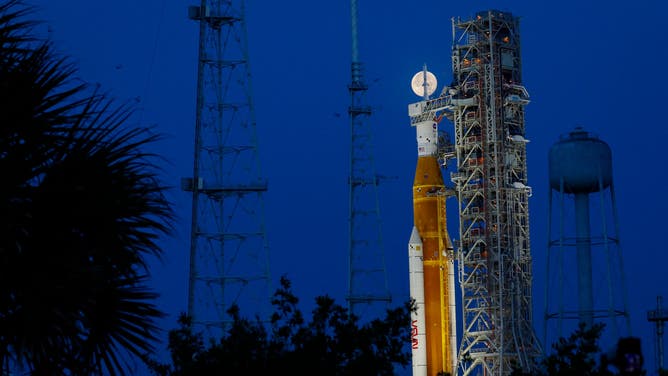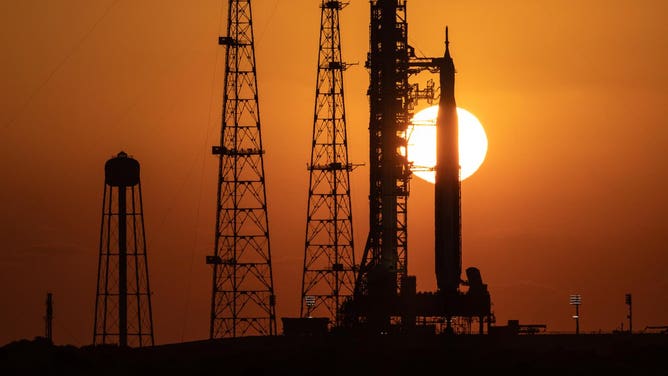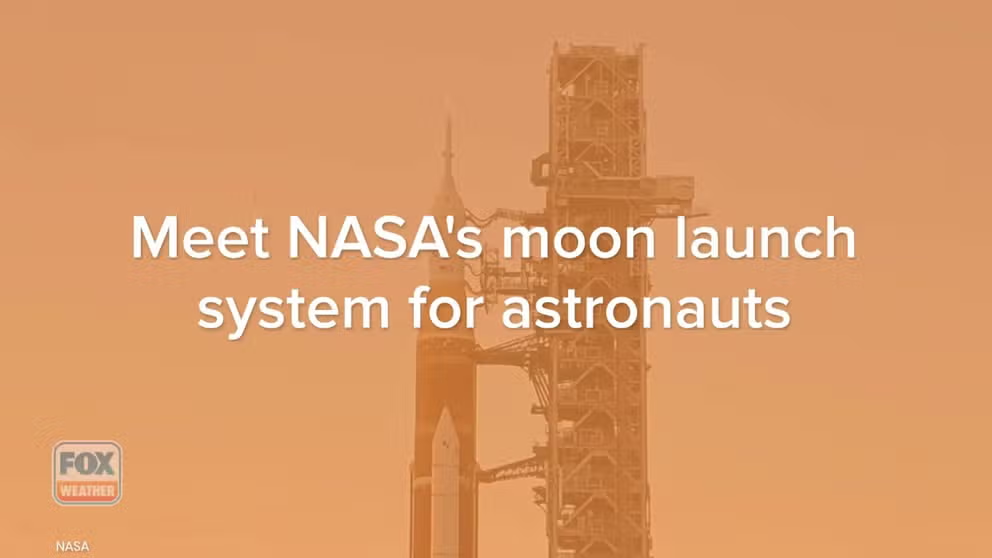NASA says Artemis moon rocket test was mostly successful; TBD if another will be needed before launch
'We'll see where the data takes us,' Launch Director Charlie Blackwell-Thompson says of the Artemis-1 wet dress rehearsal

NASAs Artemis I Moon rocket sits at Launch Pad Complex 39B at Kennedy Space Center, in Cape Canaveral, Florida, on June 15, 2022.
(EVA MARIE UZCATEGUI/AFP / Getty Images)
KENNEDY SPACE CENTER, Fla.-- After a tense day of testing NASA's Artemis moon rocket, mission managers say they celebrated after the final moments of the test, marking the first time the massive rocket nearly made it through a complete countdown.
On Monday, NASA conducted a wet dress rehearsal of the Space Launch System rocket and Orion spacecraft at Kennedy Space Center launchpad 39B. It was the fourth attempt to fuel the rocket with 750,000 gallons of super-cold fuel and run through the countdown as a dress rehearsal for the actual Artemis-1 test launch later this year.
NASA deputy associate administrator of the Exploration Systems Development Division Tom Whitmeyer congratulated the launch team for getting further in the test than the previous three attempts.
"I can't tell you how proud I am," Whitmeyer said in a call Tuesday with reporters. "We actually clapped at the end of this dress rehearsal, and we were clapping for the team. So truly, congratulations."
MEET THE MANIKINS THAT WILL HITCH A RIDE ON NASA’S MOON ROCKET
The day started at 7 a.m. when Artemis-1 Launch Director Charlie Blackwell-Thompson gave the go-ahead to begin the countdown. The primary objective for the wet dress rehearsal was to get through cryogenic fuel loading for all stages of the rocket. Previous attempts were halted before the rocket was fully fueled due to several hardware issues, including a liquid hydrogen leak.
By Monday afternoon, the rocket was nearly 100% full of liquid oxygen and liquid hydrogen propellants when engineers noticed a leak in a quick disconnect hydrogen line for the core stage and immediately halted fueling to troubleshoot the issue.
Blackwell-Thompson said the leak could be repaired with the SLS at the launchpad, but engineers are assessing if it makes sense to do it there or back inside the Vehicle Assembly Building.
"The fact that SLS has experienced two hydrogen leaks in two areas is symptomatic of the light gas, which is difficult to contain," said SLS Chief engineer Dr. John Blevins with NASA's Marshall Space Flight Center.
"It has great payoff. It's an incredible performer," Blevins said adding the downfall to hydrogen is that it "likes to leak."
Learn about NASA's new moon launch system
NASA's SLS and Orion will return humans to the moon by 2025.
Hydrogen leaks were also a reoccurring problem for the Space Shuttle Program, leading to launch scrubs and delays over the 30-year program.
Despite the leak, the SLS was fully fueled by around 6 p.m. with 196,000 gallons of liquid oxygen at minus 297 degrees Fahrenheit and 537,000 gallons of liquid hydrogen.
WATCH LIGHTNING STRIKE NEAR A MASSIVE SPACE ROCKET IN FLORIDA
With the leak still not resolved, the countdown picked up again at T-10 minutes and continued to T-29 seconds before the launch computer flagged another issue, and the countdown stopped. The goal was to get down to the T-9 second mark. Still, Monday's test achieved more for the SLS than previous tries.
Blackwell-Thompson said the last few minutes of a countdown are vital, and Monday's test run went better than expected.
"Terminal count is a very dynamic time and very time-critical, lots of time-critical events that go on in terminal count that are checked both in the flight software and on the ground and the interaction between the two," she said. "I fully expected that we might have one or two things that we might need to talk (about) in terminal count, and it was extremely smooth. There was nothing to talk about."
Blackwell-Thompson's team in the Launch Control Center has been rehearsing through simulations for years leading up to these final months before the launch.
"There's something really special about looking out at the pad and looking at the data in front of you and knowing that you're running with the flight hardware," the launch director said.
What's next for SLS is TBD

The SLS and Orion at Kennedy Space Center launchpad 39B in Florida on June 20, 2022. (Image: NASA)
NASA teams are now reviewing all the data to determine if they have enough to move ahead with launching the SLS on its maiden voyage around the moon or if yet another wet dress rehearsal will be needed.
WHY SPACE TRASH WILL CONTINUE TO BE A PROBLEM IN LOW-EARTH ORBIT
"We'll see where the data takes us," Blackwell-Thompson said.
After a successful wet dress rehearsal, NASA was expected to announce a launch date for Artemis-I but asked if the Aug. 23 to Sept. 6. launch window is still a possibility Whitmeyer said it's still too soon to tell.
"I don't think we know yet. We need to really sit down and do everything we just talked about, look at the objectives, see what we accomplish and see what additional work might be required," Whitmeyer said.
NASA managers estimated they should have a better idea of how to proceed next week.
When the Artemis-1 test flight happens, a crewless Orion will be sent on a path around the moon and back to Earth, splashing down in the Pacific Ocean. The first astronaut flight around the moon will be known as Artemis-2, leading up to the return to the moon with Artemis-3 in 2025.
CLICK HERE TO GET THE FOX WEATHER UPDATE PODCAST
Be sure to download the FOX Weather app to track any storms in your area and receive potentially life-saving weather alerts issued by the National Weather Service. The free FOX Weather livestream is also available 24/7 on the website and app and on your favorite streaming platform. The FOX Weather Update podcast also provides weather information for the entire country.
